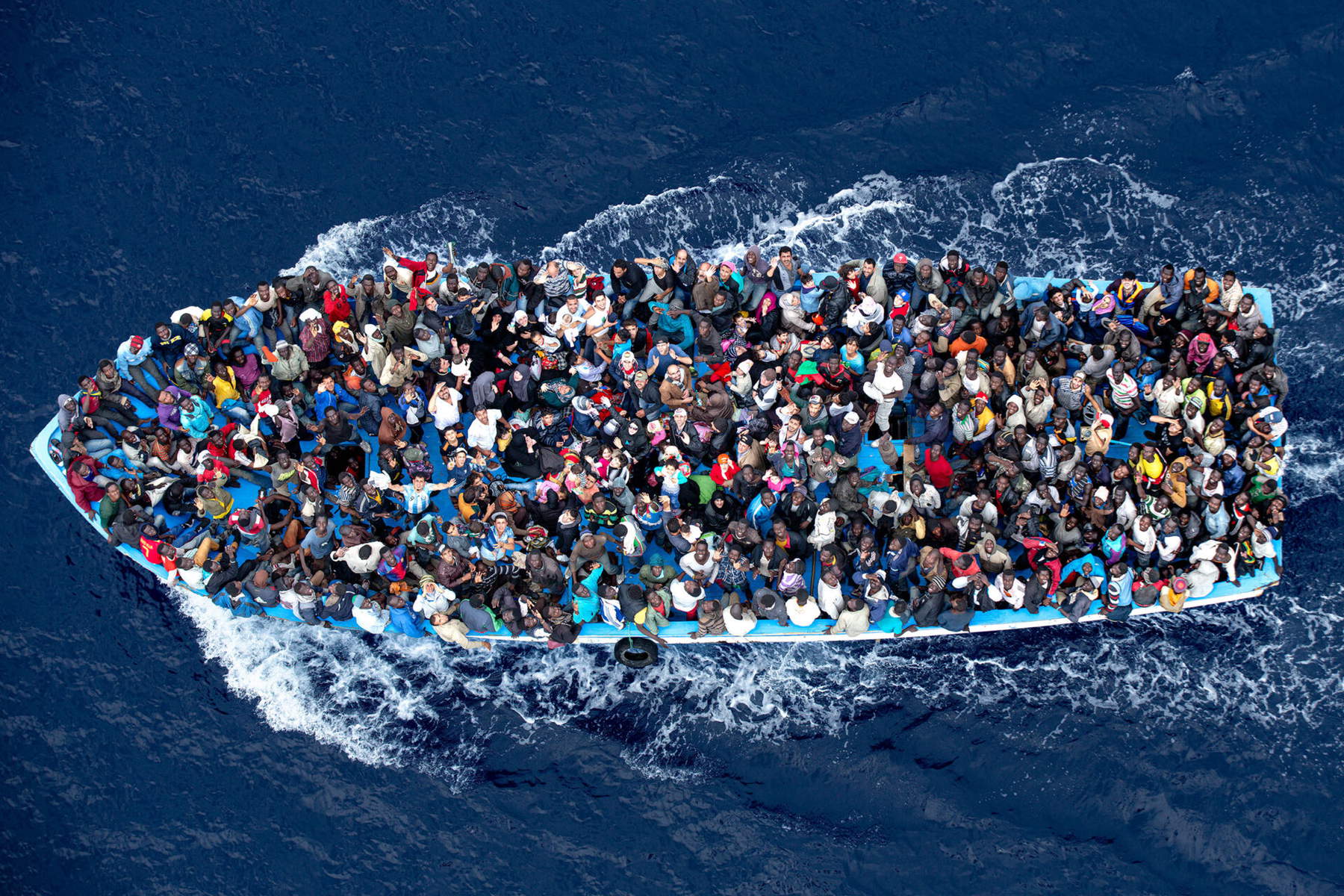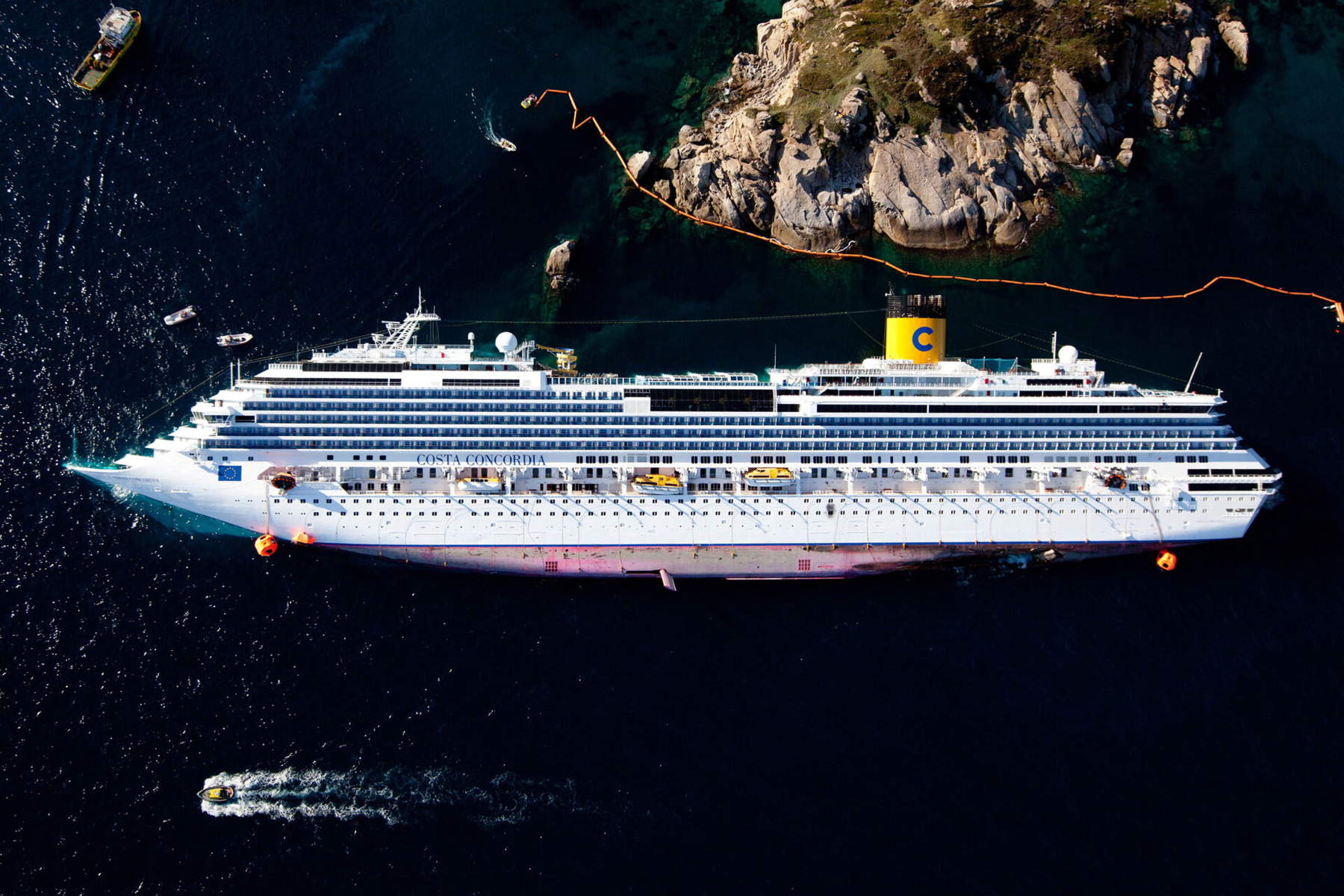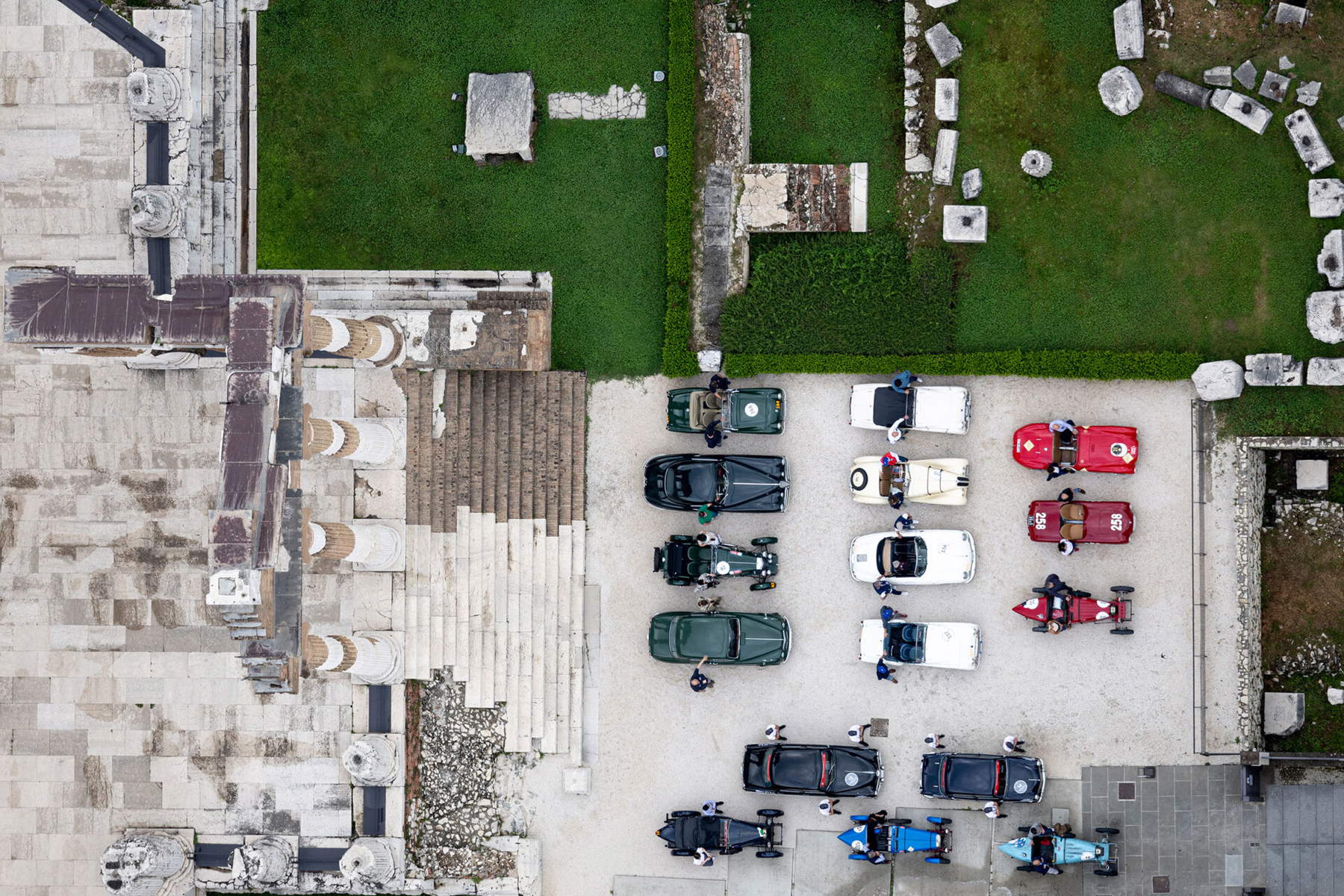Massimo Sestini's photographs on display at Brescia's Museo di Santa Giulia
The well-known shot Mare Nostrum by Massimo Sestini (Prato, 1963), winner of the 2015 World Press Photo Award, is at the center of the solo exhibition Zenit della Fotografia curated by Angelo Bucarelli that the Municipality of Brescia and Fondazione Brescia Musei, in collaboration with Freccianera Fratelli Berlucchi and with the support Fondazione Grana Padano ETS dedicate to the Tuscan photojournalist, scheduled from Sept. 24, 2024 to March 2, 2025 at the Museo di Santa Giulia in Brescia. The exhibition is the concluding act of the 2024 edition of the Brescia Photo Festival, a kermesse now in its seventh edition, promoted by the Municipality of Brescia and Fondazione Brescia Musei, in collaboration with Ma.Co.f - Centro della Fotografia Italiana, this year declined around the theme Witnesses, a term that emphasizes the ability of photographers to document the present by encouraging the reading of our history through the narrative that artists make of it, translating it into works of art that transcend the boundaries of the photographic medium. The exhibition presents a selection of 53 images by Sestini, arranged in diptychs, triptychs and polyptychs, spanning more than 30 years of his career.
The title Zenit of Photography refers to Sestini’s ability to harness, well before the advent of drones, the power of aerial and acrobatic photography, a genre of which he has become an undisputed master. His shots explore unusual angles and offer a novel view of the scene depicted. Sestini launched himself between heaven and earth to capture the essence of human life from above, even diving into the depths of the seas to capture surreal underwater visions, including emblematic shots of underwater archaeological heritage. The exhibition layout curated by the Milan-based Top Tag studio, composed of architects Nick Bellora, Nicole Bonini and Francesco Carli, focuses on crucial moments in contemporary Italian history, exploring Massimo Sestini’s most significant themes. The first section, titled Stories, presents some of his most iconic shots, including the photographs taken at Capaci a few hours after the assassination attempt on Judge Giovanni Falcone. Using a small passenger plane, from which he had removed the side door so he could look out, Sestini captured the drama of the moment. Other images include those related to the Via D’Amelio bombing, which cost the lives of Judge Paolo Borsellino and five members of his escort, as well as tragic moments such as the Costa Concordia shipwreck, the funerals of John Paul II and Benedict XVI, and the Moby Prince calamity. His photographs also document the devastating effects of the L’Aquila earthquake in 2009 and the grief of state funerals.
The Icons section collects images of some of Italy’s most famous global sports competitions, such as the Palio di Siena, the Barcolana in Trieste, and the Strade Bianche bicycle race in Tuscany. Here, two never-before-seen works dedicated to Brescia emerge, celebrating emblematic symbols of the Lombard city: the 1000 Miglia, the world’s most important historic car event, which always begins and ends in Brescia, and the archaeological site of Roman Brescia, among the most significant and well-preserved in Italy. In this context, the elegance of the cars blends with the monumentality of the Capitolium, a UNESCO World Heritage Site since 2011. The project, realized on June 11, 2024 to coincide with the start of the race, benefited from the collaboration with the 1000 Miglia and the Guardia di Finanza, which played a key role in its implementation by providing a helicopter. The image, which features the Roman Brescia Archaeological Park in an extraordinary artistic event, will be displayed in the exhibition alongside a photo depicting the preparation of the scene.
In the Heritage section, in addition to well-known images of the cathedral of Santa Maria del Fiore in Florence and Mount Etna in eruption, there are also photographs taken for the Italian Navy. Particular attention is given to the Amerigo Vespucci, considered “the most beautiful ship in the world,” accompanied by shots exploring the surface of the sea and the activities of divers from the Navy’s SDAI nucleus in Naples, engaged in monitoring mosaics from the 3rd century B.C. in the Submerged Archaeological Park of Baia. Among the themes that Massimo Sestini addressed with particular sensitivity emerges that of immigration. At the center of the exhibition is the photograph Mare nostrum, which documents the rescue of a migrant boat by the Italian Navy. The shot, searched for two years, captures the precise instant when the faces of the migrants, crammed onto the boat, light up at the sight of rescuers. Emblematic is a shot from 2024 that draws attention to the topicality of an image from a decade earlier, in which a barge was loaded only with inner tubes and meager household goods, a symbol of the tens of thousands of men, women and children who have disappeared in the Mediterranean. The review is completed with the Security section, in which Massimo Sestini documents the work of various military bodies and firefighters. Among the images, an original sequence testifying to the recovery and detonation of an unexploded mine dating back to World War II stands out. Finally, with Disturbed Photographer, the last section of the exhibition, Sestini portrays himself in a curious and ironic self-portrait embedded in a report on European prostitution. Accompanying the exhibition is a valuable volume published by Skira Arte, containing essays by Angelo Bucarelli, Denis Curti and Massimo Sestini.
The Zenit della Fotografia exhibition has its further development also in Borgonato di Corte Franca, where a section of the monographic exhibition will be set up from October 22 until March 2, 2025 in the spaces of the historic winery of Freccianera Fratelli Berlucchi, main sponsor of the exhibition and already a partner of Fondazione Brescia Musei also in the realization of the exhibition Gabriele Micalizzi. Legacy. Matter-History-Identity. Two exhibitions that run parallel: Gabriele Micalizzi is also set up in the Sala dell’Affresco of the Santa Giulia Museum and that testify to two different and complementary ways of being a photojournalist: extreme, wartime Micalizzi, tightrope walker, Massimo Sestini.
"The exhibition Massimo Sestini. Zenit of Photography is a magnificent journey through a world of amazing images. The exhibition brings together shots that have become famous, such as Mare Nostrum, an iconic and shocking depiction of a boat full of migrants awarded the World Press Photo in 2015, or those dedicated to crucial episodes in contemporary Italian history. There is no shortage, however, of previously unseen images, such as the one the master wanted to dedicate to Brescia specifically for this exhibition, portraying two emblems of our city: the Roman archaeological park and the 1000 Miglia. The Sestini exhibition that we are inaugurating today represents an extraordinary opportunity to get up close and personal with the masterpieces of one of the greatest photographers at the international level. An exhibition that, I am sure, will be able to strike and fascinate everyone, not only lovers of photography, because it uses a language that is immediate and of great impact. Once again, Brescia proves itself capable of organizing and managing cultural initiatives of great scope, living up to its vocation as a city of art," says Laura Castelletti, Mayor of Brescia.
“With the exhibition Massimo Sestini. Zenit of Photography Fondazione Brescia Musei concludes in grand style a very rich 7th Brescia Photo Festival, which has allowed to explore the theme of photographers’ eyewitness accounts of the most important events, nationally and internationally, transforming the power of the expressive medium into an artistic vehicle. This is the case of Massimo Sestini who managed to impose his own poetics of the zenith shot without betraying the deep social reasons related to the profession of photojournalism. Our thanks to Nicola Berlucchi for introducing us to Maestro Sestini, with whom a relationship of esteem and friendship was born,” announces Francesca Bazoli, president of Fondazione Brescia Musei.
"Fondazione Brescia Musei did not simply curate and produce the unpublished exhibition dedicated to Massimo Sestini, but literally contributed to the production of some of the rich content that this original monograph proposes. It could only be so, with a tightrope walker photojournalist like Massimo Sestini, who did not miss the opportunity to enrich his portfolio with a unique shot for Brescia, taken on the day of the departure of the 1000 Miglia, thanks to the fruitful collaboration with 1000 Miglia and Guardia di Finanza. The Zenit of Photography exhibition seals a great edition of the Brescia Photo Festival 2024, for which our institution testifies every year of more care and attention, directed to the event as well as to that extraordinary expressive medium that is photography when it becomes art," says Stefano Karadjov, Director Fondazione Brescia Musei.
"Massimo Sestini’s photographs are works of art, unusual, unprecedented and exciting views from above of the world in which we live. They are the fruit of a refined technique and a passionate search for beauty combined with a great mastery in the choice of unrepeatable moments, magnificent geometries and wonders of light that restore enchantment and wonder. Our quest as producers of Franciacorta of excellence has so many assonances with Massimo Sestini’s that the esteem, friendship and collaboration that have helped make possible the Zenit of Photography exhibition at Santa Giulia, of which Freccianera Fratelli Berlucchi is Main Partner and organizer of the side exhibition in the Borgonato winery that we will open to the public next October 22," says Nicola Berlucchi, Managing Director of Freccianera Fratelli Berlucchi.
“Curating the exhibition of an author like Massimo Sestini is a personal enrichment and the privilege of being able to be an ambassador to the public of a passion, a spirit of service and a rare talent that make his photographs true iconic works of art of our history,” says Angelo Bucarelli, curator.






Notes on the artist
Massimo Sestini was born in Prato in 1963. He is one of the most important international photojournalists. Thanks to an endless production, alternating between infiltrated reporter and official photographer, Sestini has chronicled like no other four decades of the history of Italian customs, politics and society. He began with the rock portrait exhibition Un diciaettenne ed il suo obiettivo (Florence, 1980). The first scoops arrive in the mid-1980s: from Charles of England photographed in Recanati while painting a watercolor, to Licio Gelli filmed in Geneva while being taken to prison as soon as he turned himself in after escaping to Argentina, to the Rapido 904 bombing in the San Benedetto Val di Sambro tunnel, with which he gets his first cover story in the German weekly Stern. From that moment on, Massimo Sestini, in addition to maintaining a constant focus on the news, evidenced by the founding of the agency that bears his name and has been raising young photojournalists ever since, devotes himself to major current events. The goal is to be on the news, whatever the means of getting there; even when it seems impossible. His photographs make the front pages of the world’s major newspapers. Constant technological updating, immediate insight into the opportunities of digital, and the use of increasingly powerful telephoto lenses will be his allies. He will thus witness the Moby Prince tragedy and author the aerial photos of Capaci and Palermo following the assassination attempts on Giovanni Falcone and Paolo Borsellino. Aerial photos became a constant of his, a premise to more recent zenithal ones. The following years will bring more exclusives: aerial shots of the Jubilee, the Genoa G8 riots, the funeral of Pope John II. In 2012 he dives with Navy divers inside the newly sunken Concordia. In 2014 he is aboard the Frigate Bergamini, witnessing the Mare Nostrum rescue operations off the coast of Libya. From an aerial portrait of Italy - from Lampedusa to the Dolomites - aboard Police helicopters over a two-year period of work, the exhibition Horizons of Italy from the State Police helicopters will be born, inaugurated at the Quirinale Palace in May 2016 in the presence of the President of the Republic, Sergio Mattarella.
 |
| Massimo Sestini's photographs on display at Brescia's Museo di Santa Giulia |
Warning: the translation into English of the original Italian article was created using automatic tools. We undertake to review all articles, but we do not guarantee the total absence of inaccuracies in the translation due to the program. You can find the original by clicking on the ITA button. If you find any mistake,please contact us.





























